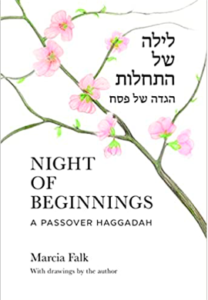By Michael R. Mantell, Ph.D.

SAN DIEGO — When a Haggadah is written by a founding mother of feminist Judaism, as poet and author Marcia Falk is described, the reader can rest assured a fresh view of Jewish worship complete with beauty, artistic creativity, and love will fill the Seder. This Haggadah brings radical new blessings that turn from the traditional patriarchal-themed Seder, affording those who delve into it a revolutionary meditative direction for prayer.
In this Haggadah, we delve far more deeply into the Exodus narrative than many traditional Seders may include. With its focus on women’s roles in the Pesach story, the reader gains greater insights into the actions of Miriam, Pharoah’s daughter, the midwives Shifrah and Pu’ah.
Whether the Seder is a solemn time of rules with tiers of customs, a time simply for family to gather and joyfully celebrate Jewish heritage, or an evening of skeptical relevance, Night of Beginnings will enable all to find a spiritually moving and thoughtful experience. That’s the real value of this work – it’s inclusive and relevant embellishments, gender-sensitive English translations, contemporary links, non-rote luminous vitality, and new answers to the question, “Why is this night different than all other nights?”
In the words of the author, “…this Haggadah is an attempt to reveal meanings beneath the surface of the Pesach ritual and to deepen our personal connections to the holiday.”

Perhaps what is most graphically brought to life in this Haggadah is the manner in which Falk illuminates b’rachot, kavanot, and the Maggid. Her blessings “express a theology that differs distinctly from that of the traditional rabbinic blessings as well as from that of the Bible story…Their inclusive language makes room for women to find and use [their] voices more full-throatedly than [we] were able to do with the patriarchal prayers [we] inherited from the early rabbis.” Included in this color-coded Haggadah, are amplifications of the blessings, with kavanot, described as the “Seder’s heart.” These longer prose-poems and meditations are actually invitations to dig more deeply and to “linger over images, themes, and motifs, allowing…to enter more fully and more personally int the experience of the night.” With adorned poems, psalms, songs and traditional readings, a grander sense of coherence is palpable, opening up a richer, deeper, better connected Pesach experience, with a new relationship to Jewish tradition, and greater personal insights…leading to a strikingly more potent “personal potential for liberation,” as Falk describes her aim.
From the Haggadah, we come near the end of the Seder with the “Promise of Elijah:”
“We open the door to Elijah
And meet ourselves at the threshold.
May we find our callings here
To Mend the broken world
And Make whole
What is wounded and torn.
Soon- in our time-
May healing blossom
In our hands.”
I believe many will find crossing Falk’s shining new haggadic bridge from the traditional to a fresh and contemporary view, most engaging, charming, and appealing. Of course, you can always infuse the standby Maxwell House Haggadah with its 15 steps from Kadesh to Nirtzah with wonderful kavanot from Night of Beginnings.
*
Michael R. Mantell, Ph.D., prepares a weekly D’var Torah for Young Israel of San Diego, where he and his family are members. They are also active members of Congregation Adat Yeshurun. He may be contacted via michael.mantell@sdjewishworld.com